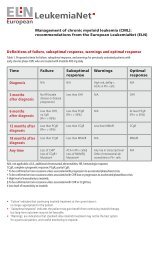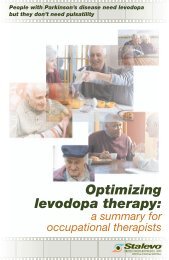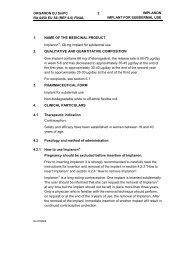Gracial ProdMonograph_cover - epgonline.org
Gracial ProdMonograph_cover - epgonline.org
Gracial ProdMonograph_cover - epgonline.org
Create successful ePaper yourself
Turn your PDF publications into a flip-book with our unique Google optimized e-Paper software.
Summary of product characteristics<br />
2. Tumors<br />
• An increased risk of cervical cancer in long-term<br />
users of COCs has been reported in some<br />
epidemiological studies, but there continues to<br />
be controversy about the extent to which this<br />
finding is attributable to the confounding effects<br />
of sexual behavior and other factors such as<br />
human papilloma virus (HPV).<br />
• A meta-analysis from 54 epidemiological studies<br />
reported that there is a slightly increased<br />
relative risk (RR = 1.24) of having breast cancer<br />
diagnosed in women who are currently using<br />
COCs. The increased risk gradually disappears<br />
during the course of the 10 years after cessation<br />
of COC use. Because breast cancer is rare in<br />
women under 40 years of age, the excess<br />
number of breast cancer diagnoses in current<br />
and recent COC users is small in relation to the<br />
lifetime risk of breast cancer. These studies do<br />
not provide evidence for causation. The<br />
observed pattern of increased risk may be due<br />
to an earlier diagnosis of breast cancer in COC<br />
users, the biological effects of COCs or a<br />
combination of both. The breast cancers<br />
diagnosed in ever-users tend to be less<br />
advanced clinically than the cancers diagnosed<br />
in never-users.<br />
• In rare cases, benign liver tumors, and even<br />
more rarely, malignant liver tumors have been<br />
reported in users of COCs. In isolated cases,<br />
these tumors have led to life-threatening intraabdominal<br />
hemorrhages. A hepatic tumor<br />
should be considered in the differential<br />
diagnosis when severe upper abdominal pain,<br />
liver enlargement or signs of intra-abdominal<br />
hemorrhage occur in women taking COCs.<br />
3. Other conditions<br />
• Women with hypertriglyceridemia, or a family<br />
history thereof, may be at an increased risk of<br />
pancreatitis when using COCs.<br />
• Although small increases in blood pressure have<br />
been reported in many women taking COCs,<br />
clinically relevant increases are rare. A<br />
relationship between COC use and clinical<br />
hypertension has not been established.<br />
However, if a sustained clinically significant<br />
hypertension develops during the use of a COC<br />
then it is prudent for the physician to withdraw<br />
the COC and treat the hypertension. Where<br />
considered appropriate, COC use may be<br />
resumed if normotensive values can be achieved<br />
with antihypertensive therapy.<br />
• The following conditions have been reported to<br />
occur or deteriorate with both pregnancy and<br />
COC use, but the evidence of an association<br />
with COC use is inconclusive: jaundice and/or<br />
pruritus related to cholestasis; gallstone<br />
formation; porphyria; systemic lupus<br />
erythematosus; hemolytic uremic syndrome;<br />
Sydenham’s chorea; herpes gestationis;<br />
otosclerosis-related hearing loss.<br />
• Acute or chronic disturbances of liver function<br />
may necessitate the discontinuation of COC use<br />
until markers of liver function return to normal.<br />
Recurrence of cholestatic jaundice which<br />
occurred first during pregnancy or previous use<br />
of sex steroids necessitates the discontinuation<br />
of COCs.<br />
• Although COCs may have an effect on peripheral<br />
insulin resistance and glucose tolerance, there is<br />
no evidence for a need to alter the therapeutic<br />
regimen in diabetics using COCs. However,<br />
diabetic women should be carefully observed<br />
while taking COCs.<br />
• Crohn’ s disease and ulcerative colitis have been<br />
associated with COC use.<br />
• Chloasma may occasionally occur, especially in<br />
women with a history of chloasma gravidarum.<br />
Women with a tendency to chloasma should<br />
avoid exposure to the sun or ultraviolet radiation<br />
while taking COCs.<br />
4.4.2. Medical examination/consultation<br />
A complete medical history and physical<br />
examination should be taken prior to the initiation<br />
or reinstitution of COC use, guided by the<br />
contraindications (Section 4.3) and warnings<br />
(Section 4.4.1), and should be repeated at least<br />
annually during the use of COCs. Periodic medical<br />
assessment is also of importance because<br />
contraindications (e.g. a transient ischemic attack,<br />
etc.) or risk factors (e.g. a family history of venous<br />
or arterial thrombosis) may appear for the first<br />
time during the use of a COC. The frequency and<br />
nature of these assessments should be adapted to<br />
the individual woman but should generally include<br />
special reference to blood pressure, breasts,<br />
abdomen and pelvic <strong>org</strong>ans, including cervical<br />
cytology, and relevant laboratory tests.<br />
Women should be advised that oral contraceptives<br />
do not protect against HIV infections (AIDS) and<br />
other sexually transmissible diseases.<br />
4.4.3 Reduced efficacy<br />
The efficacy of COCs may be reduced in the event<br />
of missed tablets (Section 4.2.3), vomiting (Section<br />
4.2.4) or concomitant medication (Section 4.5.1).<br />
51
















